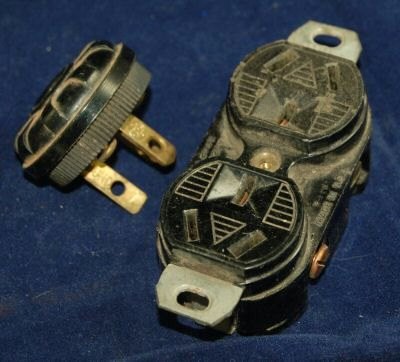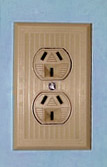General Discussion
Forum home - Go back to General discussion
|
Australian power plugs
|
|
|
Return to top of page · Post #: 1 · Written at 9:09:29 AM on 13 July 2014.
|
|
|
|
Location: Blue Mountains, NSW
Member since 10 March 2013 Member #: 1312 Postcount: 401 |
|
Apart from early types, there seems to be four main variations of three pin power plugs used in Australia over the years. The first are Bakelite with the screws and wires exposed in an open base. The second is very similar but with the screws and wires enclosed. The third is a more modern rounded looking Bakelite plug that came in various colours and the fourth is the flexible plastic plug that is still with us today. Apart from the modern plug changing to have insulated pins in 2004 and the neutral and active pins being specified some time during the 1950's, I can't find any information to date when the different styles were intruduced. |
|
|
Return to top of page · Post #: 2 · Written at 2:32:59 PM on 13 July 2014.
|
|
|
|
Location: Sydney, NSW
Member since 28 January 2011 Member #: 823 Postcount: 6908 |
|
Interesting question. |
|
|
Return to top of page · Post #: 3 · Written at 4:49:50 PM on 13 July 2014.
|
|
|
|
Location: Maclean, NSW
Member since 30 May 2008 Member #: 291 Postcount: 341 |
|
Try some info here |
|
|
Return to top of page · Post #: 4 · Written at 6:11:11 PM on 13 July 2014.
|
|
|
|
Location: Sydney, NSW
Member since 28 January 2011 Member #: 823 Postcount: 6908 |
|
^ Good article. I added Ring Grip to my earlier post. |
|
|
Return to top of page · Post #: 5 · Written at 6:50:59 PM on 13 July 2014.
|
|
|
|
Location: Blue Mountains, NSW
Member since 10 March 2013 Member #: 1312 Postcount: 401 |
|
It is a good article. |
|
|
Return to top of page · Post #: 6 · Written at 7:18:54 PM on 13 July 2014.
|
|
|
|
Location: Sydney, NSW
Member since 28 January 2011 Member #: 823 Postcount: 6908 |
|
I recently saw a pale green damaged HPM Bakelite sell for nearly $40 on eBay! The seller is an acquaintance of mine and he was astounded, he was going to throw it out. |
|
|
Return to top of page · Post #: 7 · Written at 8:59:04 PM on 13 July 2014.
|
|
|
|
Location: Maclean, NSW
Member since 30 May 2008 Member #: 291 Postcount: 341 |
|
I still have some 1940's NOS HPM light switches that belonged to my grand father and were surplus when he built his house. Yes, he was a hoarder also |
|
|
Return to top of page · Post #: 8 · Written at 9:46:03 PM on 13 July 2014.
|
|
|
|
Administrator
Location: Naremburn, NSW
Member since 15 November 2005 Member #: 1 Postcount: 7587 |
|
There were a few other makers of plug tops and sockets. I will list those I can trace tomorrow. They all eventually either folded or got consumed by Clipsal and HPM. ‾‾‾‾‾‾‾‾‾‾‾‾‾‾‾‾‾‾‾‾‾‾‾‾‾‾‾‾‾‾‾‾‾‾‾‾‾‾‾‾‾‾‾‾‾‾‾‾‾‾‾‾‾‾‾‾‾‾‾‾‾‾‾‾‾‾‾‾ A valve a day keeps the transistor away... |
|
|
Return to top of page · Post #: 9 · Written at 5:35:51 AM on 14 July 2014.
|
|
|
|
Location: Oradell, US
Member since 2 April 2010 Member #: 643 Postcount: 835 |
|
The USA used plugs and outlets of the Australian pattern before our more modern grounding pattern |
|
|
Return to top of page · Post #: 10 · Written at 8:40:59 AM on 14 July 2014.
|
|
|
|
Location: Sydney, NSW
Member since 28 January 2011 Member #: 823 Postcount: 6908 |
|
Note that British-aligned systems (including Australia) see the light switch up for off and down for on under normal circumstances. US-aligned systems are the opposite. |
|
|
Return to top of page · Post #: 11 · Written at 12:55:50 PM on 14 July 2014.
|
|
|
|
Location: Somewhere, USA
Member since 22 October 2013 Member #: 1437 Postcount: 896 |
|
I just got my first bakelite female mains socket for an extension cord |
|
|
Return to top of page · Post #: 12 · Written at 1:00:43 PM on 14 July 2014.
|
|
|
|
Location: Sydney, NSW
Member since 28 January 2011 Member #: 823 Postcount: 6908 |
|
It's the first time I've seen that. |
|
|
Return to top of page · Post #: 13 · Written at 9:51:38 PM on 14 July 2014.
|
|
|
|
Administrator
Location: Naremburn, NSW
Member since 15 November 2005 Member #: 1 Postcount: 7587 |
|
I wonder if the US convention derives from knife switches, where you push them upwards to close the circuit. (Having them operate the other way would be unsafe as gravity could intervene.) ‾‾‾‾‾‾‾‾‾‾‾‾‾‾‾‾‾‾‾‾‾‾‾‾‾‾‾‾‾‾‾‾‾‾‾‾‾‾‾‾‾‾‾‾‾‾‾‾‾‾‾‾‾‾‾‾‾‾‾‾‾‾‾‾‾‾‾‾ A valve a day keeps the transistor away... |
|
|
Return to top of page · Post #: 14 · Written at 7:54:04 AM on 15 July 2014.
|
|
|
|
Location: Blue Mountains, NSW
Member since 10 March 2013 Member #: 1312 Postcount: 401 |
|
With a 35 metre driveway I think I successfully manage to break most of those rules every time I get the blower out to clean it! |
|
|
Return to top of page · Post #: 15 · Written at 1:11:38 PM on 15 July 2014.
|
|
|
|
Location: Bathurst, NSW
Member since 7 August 2008 Member #: 336 Postcount: 411 |
|
Thanks for the article Scraps as it is interesting to see what went on 50 or more years ago. |
|
|
You need to be a member to post comments on this forum.
|
|

Sign In

Vintage Radio and Television is proudly brought to you by an era where things were built with pride and made to last.
DISCLAIMER: Valve radios and televisions contain voltages that can deliver lethal shocks. You should not attempt to work on a valve radio or other electrical appliances unless you know exactly what you are doing and have gained some experience with electronics and working around high voltages. The owner, administrators and staff of Vintage Radio & Television will accept no liability for any damage, injury or loss of life that comes as a result of your use or mis-use of information on this website. Please read our Safety Warning before using this website.
WARNING: Under no circumstances should you ever apply power to a vintage radio, television or other electrical appliance you have acquired without first having it checked and serviced by an experienced person. Also, at no time should any appliance be connected to an electricity supply if the power cord is damaged. If in doubt, do not apply power.
Shintara - Keepin' It Real · VileSilencer - Maintain The Rage

 Think I have some power points as well.
Think I have some power points as well.

 60Hz, here our power companies supply homes with a pair of 120V lines, essentially 240V with a grounded centertap. As my Aussue radios all use power transformers, they don't care that the mains pins are both hot.
60Hz, here our power companies supply homes with a pair of 120V lines, essentially 240V with a grounded centertap. As my Aussue radios all use power transformers, they don't care that the mains pins are both hot. It's the first time I've seen that.
It's the first time I've seen that.